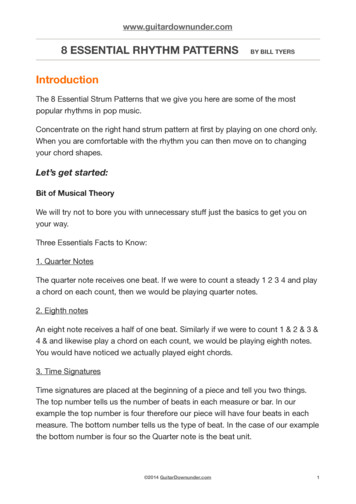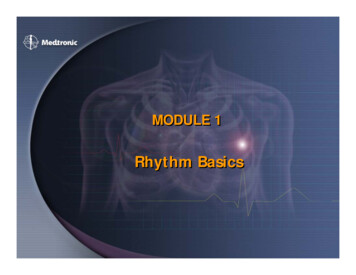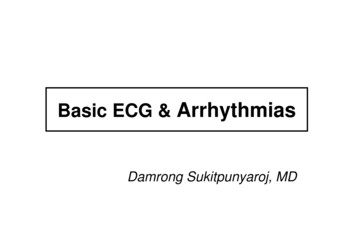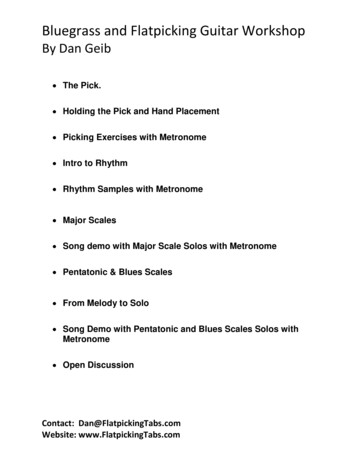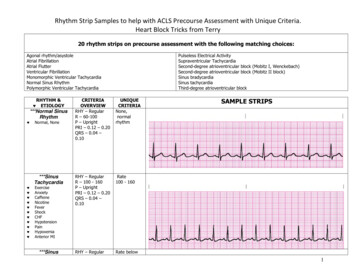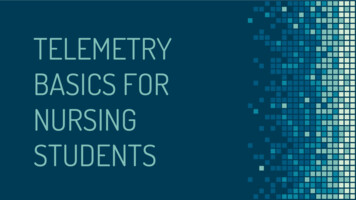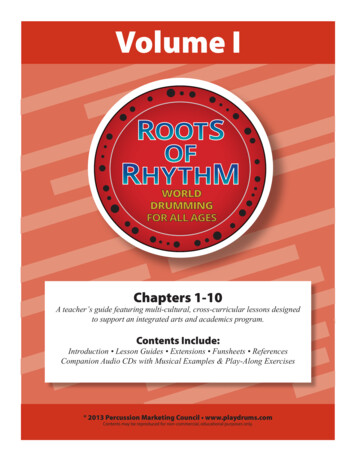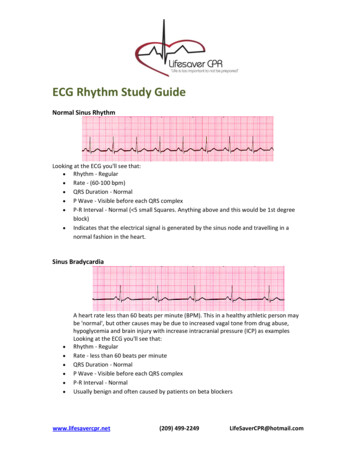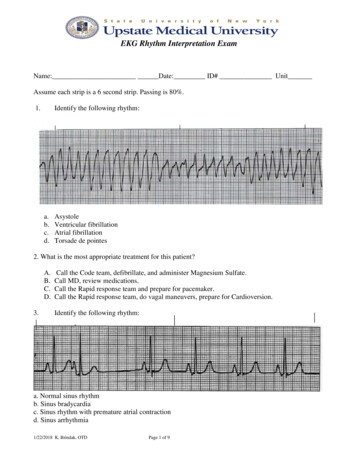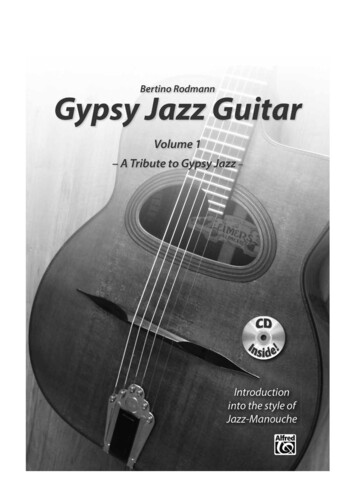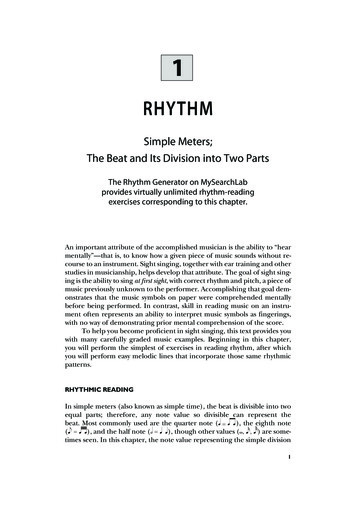
Transcription
1RhythmSimple Meters;The Beat and Its Division into Two PartsThe Rhythm Generator on MySearchLabprovides virtually unlimited rhythm-readingexercises corresponding to this chapter.An important attribute of the accomplished musician is the ability to “hearmentally”—that is, to know how a given piece of music sounds without recourse to an instrument. Sight singing, together with ear training and otherstudies in musicianship, helps develop that attribute. The goal of sight singing is the ability to sing at first sight, with correct rhythm and pitch, a piece ofmusic previously unknown to the performer. Accomplishing that goal demonstrates that the music symbols on paper were comprehended mentallybefore being performed. In contrast, skill in reading music on an instrument often represents an ability to interpret music symbols as fingerings,with no way of demonstrating prior mental comprehension of the score.To help you become proficient in sight singing, this text provides youwith many carefully graded music examples. Beginning in this chapter,you will perform the simplest of exercises in reading rhythm, after whichyou will perform easy melodic lines that incorporate those same rhythmicpatterns.Rhythmic ReadingIn simple meters (also known as simple time), the beat is divisible into twoequal parts; therefore, any note value so divisible can represent thebeat. Most commonly used are the quarter note ( ), the eighth note( ), and the half note ( ), though other values ( , , ) are sometimes seen. In this chapter, the note value representing the simple division1# 110118 Cust: Pearson Au: Ottman Pg. No. 1M01 OTTM0000 09 SE CH01.indd1 Singing 9e Server: S4CarlisleTitle: Music for SightKShort / NormalDESIGN SERVICES OFS4carlisle17/10/12Publishing Services8:06 PM
of the beat (that is, half of the beat) will be the shortest note value used. Inreading, follow these suggestions:1. Rhythmic syllables. Accurate rhythmic reading is best accomplished throughthe use of spoken or sung rhythmic syllables. Any spoken method (even aneutral syllable) is preferable to clapping or tapping for a variety of reasons:dynamics and sustained notes are more easily performed vocally, faster tempos are possible, and vocalizing leaves the hands free for conducting. Thereare a variety of good rhythmic syllable systems in current use; several popularsystems are illustrated in Appendix A.2. The conductor’s beat. The use of conductor’s beats is highly recommended.Shown below are hand-movement patterns for two beats, three beats, andfour beats per measure. Successive downbeats of each pattern coincide withsuccessive bar lines. You should conduct with your right hand.The Conductor’s Beats: two beats, three beats, and four beatsper measure214312213The downbeat (1) drops in a straight line and describes a small bounce atthe instant the first beat occurs. The first downbeat is preceded by an upbeat,beginning at the point of the last beat of the pattern being used. Therefore,the last beat of each measure is the upbeat for the following measure.Practice these three conductor’s beats without reading or singing. Next, withthe left hand, tap twice for each beat of the conductor’s beat. These tapsrepresent the normal simple division of the beat-note value. When you nolonger have to concentrate on these hand movements, you are ready to beginrhythmic reading and sight singing.3. Striving for continuity. It should be obvious that only the first performanceof an exercise can be considered reading at first sight. (After that, you arepracticing!) Therefore, on the first try, you should not stop to correct errors or to study what to do next. As you read an exercise, use the conductor’s beat and tapping to keep going without pause until the very end. Ifyou make a mistake, don’t hesitate or stop; the next “1” (downbeat) willbe the next bar line where you can pick up your reading and continue tothe end. If you made errors or lost your place, you can review and practicein anticipation of doing better on the next exercise. Follow this procedure beginning with the very first exercises. Conducting and tapping easy exercises now is the best way to prepare yourself for the more difficultexercises to follow.4. Notation for rhythmic reading. Exercises such as a on the following page aredesigned specifically for rhythmic reading and therefore use a simple oneline staff. However, reading rhythmic notation from a melodic line, as in example b, should begin as soon as possible. As seen in this pair of examples2# 110118 Cust: Pearson Au: Ottman Pg. No. 2M01 OTTM0000 09 SE CH01.indd2 Singing 9e Server: S4CarlisleTitle: Music for SightKShort / NormalDESIGN SERVICES OFS4carlisle17/10/12Publishing Services8:06 PM
(illustrated with one of many possible solmization systems), there is no difference in the resulting rhythmic performance.The melodies of Chapters 2 and 3 include only the same type of rhythmpatterns found in this chapter.Section 1. The quarter note as the beat unit. Beat-note valuesand larger only: 1 beat, 2 beats, 3 beats, 4 beats.Not all exercises begin on the first beat of the measure. Determine thebeat number of the first note before reading. If there is an anacrusis (i.e., apick-up), silently count from the downbeat and enter on the appropriate beat.1.11.21.31.41.51.61.71.83# 110118 Cust: Pearson Au: Ottman Pg. No. 3M01 OTTM0000 09 SE CH01.indd3 Singing 9e Server: S4CarlisleTitle: Music for SightKShort / NormalDESIGN SERVICES OFS4carlisle17/10/12Publishing Services8:06 PM
1.91.10Section 2. The quarter note as the beat unit and its division ( ).Dotted notes and tied notes.(((A tie connects two notes; simply continue the first note through thesecond without rearticulation ( ). A dot extends the preceding note byhalf its value ( . , . ).1.111.121.131.141.151.161.174# 110118 Cust: Pearson Au: Ottman Pg. No. 4M01 OTTM0000 09 SE CH01.indd4 Singing 9e Server: S4CarlisleTitle: Music for SightKShort / NormalDESIGN SERVICES OFS4carlisle17/10/12Publishing Services8:06 PM
1.181.191.201.211.221.231.245# 110118 Cust: Pearson Au: Ottman Pg. No. 5M01 OTTM0000 09 SE CH01.indd5 Singing 9e Server: S4CarlisleTitle: Music for SightKShort / NormalDESIGN SERVICES OFS4carlisle17/10/12Publishing Services8:06 PM
Section 3. Two-part drills.Suggested methods of performance:1. One person: Tap both lines, using both hands.2. One person: Recite one line while tapping the other.3. Two people: Each recite a line.1.251.261.271.286# 110118 Cust: Pearson Au: Ottman Pg. No. 6M01 OTTM0000 09 SE CH01.indd6 Singing 9e Server: S4CarlisleTitle: Music for SightKShort / NormalDESIGN SERVICES OFS4carlisle17/10/12Publishing Services8:06 PM
1.29Only the meter signatures 24, 43, and 44 will be found in melodies from Section 1 of Chapter 2. Sight-singing studies may begin there at this time.Section 4. Note values other than the quarter note as beat values.The half note, the eighth note, and the sixteenth note are also usedto represent the beat. The signatures 22 ( ), 23, and 83 are commonly used inwritten music. Others are occasionally seen. See Chapter 2, Section 3, formelodic examples of less common signatures.In 1.30, examples a, b, c, and d all sound the same when the durationof each of their beat-note values ( , , , and ) is the same.1.307# 110118 Cust: Pearson Au: Ottman Pg. No. 7M01 OTTM0000 09 SE CH01.indd7 Singing 9e Server: S4CarlisleTitle: Music for SightKShort / NormalDESIGN SERVICES OFS4carlisle17/10/12Publishing Services8:06 PM
1.311.321.331.341.351.361.371.381.391.401.418# 110118 Cust: Pearson Au: Ottman Pg. No. 8M01 OTTM0000 09 SE CH01.indd8 Singing 9e Server: S4CarlisleTitle: Music for SightKShort / NormalDESIGN SERVICES OFS4carlisle17/10/12Publishing Services8:06 PM
1.421.431.441.451.461.471.481.499# 110118 Cust: Pearson Au: Ottman Pg. No. 9M01 OTTM0000 09 SE CH01.indd9 Singing 9e Server: S4CarlisleTitle: Music for SightKShort / NormalDESIGN SERVICES OFS4carlisle17/10/12Publishing Services8:06 PM
1.501.511.521.53Section 5. Two-part drills.1.541.551.5610# 110118 Cust: Pearson Au: Ottman Pg. No. 10M01 OTTM0000 09 SE CH01.indd10Singing 9e Server: S4CarlisleTitle: Music for SightKShort / NormalDESIGN SERVICES OFS4carlisle17/10/12Publishing Services8:06 PM
1.571.581.591.601.611.6211# 110118 Cust: Pearson Au: Ottman Pg. No. 11M01 OTTM0000 09 SE CH01.indd11Singing 9e Server: S4CarlisleTitle: Music for SightKShort / NormalDESIGN SERVICES OFS4carlisle17/10/12Publishing Services8:06 PM
Notation for rhythmic reading. Exercises such as a on the following page are designed specifically for rhythmic reading and therefore use a simple one-line staff. However, reading rhythmic notation from a melodic line, as in example b, should begin as soon as possible. As seen in this pair of examples 1 2 3 2 1 3 2 4 1

